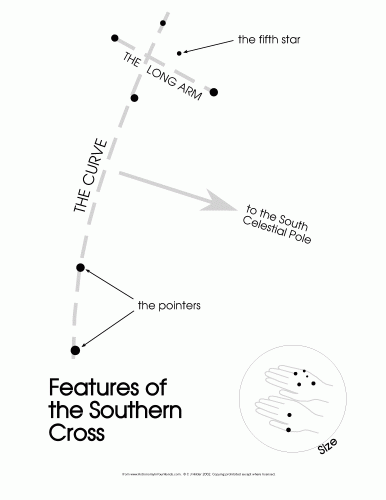| Finding
the Southern Cross
There are many crosses in the
skies, so check these keys before deciding you have found the
Southern Cross. The two keys to finding the Southern Cross are:
- The Pointers. These
are very bright stars and they make a distinctive shape with
the cross.
- The Fifth Star. Many
crosses have a fifth star, and it acts like a
"signature." You can tell which cross it is from the
location of the fifth star.
- The Southern Cross has
its fifth star roughly midway between two of its main four
stars.
- If you are looking from a
city this star might be very faint, or even impossible to
see, due to the amount of light coming from
streetlights.
- If this is the case, you
will have to rely on the distinctive shape made by the
Southern Cross and pointers.
|
The Southern Cross used to be visible in
Greece low on the southern horizon, and it was known to the ancient Greeks
and Chaldeans who included it on their star maps. However, the precession
(slow wobble) of the earth's axis has steadily carried this part of the
sky southwards. 2000 years ago the Southern Cross was just fully visible
from Palestine at the right time of year, while today it is just seen from
southern Egypt.
 |
- Special features of the
Southern Cross:
- The brightest star, Acrux, is a
double star.
- Beta Crux, or Mimosa, is also a
double of purple-white stars.
- One of the reddest stars known,
a 10th magnitude carbon star, is beside Mimosa.
- Gamma Crux is a red giant star.
- The "Jewel Box" is a
fine open cluster of 50 red, white and blue stars about 7600
Light Years away.
|
THE POINTERS
- The two brightest stars in the
constellation Centaurus, are popularly known as the Pointers, as they
point to the Southern Cross. Alpha Centauri is the brightest, at -0.3
magnitude, but it has two clever advantages to achieve this:
- it is only 4.3 light years away
- it is actually a triple star
system: two yellow stars like our sun circle each other one
light-hour apart (that's about as far as the Sun to Uranus), while
a third dwarf star, Proxima Centauri, circles both a couple of
light-months away.
- When we look at Alpha Centauri
through the telescope, the separation between the two stars gives us
an idea of the size of our Solar System if seen from 4 light years
away.
|